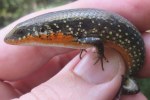Eutropis macularia

English name: Speckled Forest Skink (aka “Bronze Mabuya” or “Bronze Grass Skink”)
Scientific name: Eutropis macularia (Formerly Mabuya macularia)
Thai name: Ching-laen Lak La
Description: To 18 cm long. Snout to base of tail is up to 7.5 cm. A slender skink of average size. Brown to grey with a dark stripe on each side bordered with white or cream. Dark stripe speckled with white in adults and usually fades out into background color before reaching the hind limbs. Body scales can be iridescent in younger individuals. Head is no wider than body and narrows to the nose. Dark body stripe continues on head up to eye. Adults can have orange throat. Underbelly is dirty cream.
Similar Species: Common Sun Skink is larger, heavier, and usually lacks striping on the sides.
Long-tailed Sun Skink is larger, has a much longer tail, and has more distinct body striping.
Habitat: Frequents open forest, usually foraging or basking among low vegetation. Can also be found in plantations and abandoned lots.
Place in the ecosystem: Eats insects. Eaten by snakes and birds.
Danger to humans: May bite when handled, but is not dangerous.
Conservation status and threats: Is a widespread species and has no known conservation threats.
Interesting facts: Speckled Forest Skinks have a rough patch of scales on their ankles and a pocket of skin where the leg meets the body. The exact purpose of these scale features is unknown, but parasitic mites congregate in those areas. Some experts believe that these adaptations concentrate the mites in limited areas of the skinks’ bodies, minimizing their impact elsewhere on the skink.
I know of no records of Speckled Forest Skinks in the Bangkok area, but multiple experts believe that it may be found here. They can be found in all other parts of Thailand.
References:
Ecology Asia: Speckled Forest Skink
Wikipedia: Eutropis macularia
Michael Cota, personal communication.
A Photographic Guide to Snakes and Other Reptiles of Peninsular Malaysia, Singapore and Thailand
A Field Guide to the Reptiles of South-East Asia
The Lizards of Thailand








